Kansai is known as a region of contrasts.
It is central to Japan’s spiritual and cultural development and is where modern Japanese civilisation evolved.
At its heart lies Osaka, a city that knows how to enjoy life. But it’s Kyoto, Japan’s former capital, that most tourists flock to.
Kansai: Bringing together the best of modern and traditional Japan
However, if you’re already familiar with Kyoto, or want to avoid the tourist hordes, there are several destinations in and around Osaka that are well worth building into any itinerary.
And you only need one week to see the highlights.
From Japan's food capital Osaka, to the Buddhist mountain retreat of Koyasan, plus: Kobe, Himeji, Arima Onsen and Sakai.
Here's how to spend a week in Kansai without visiting Kyoto.
How To Spend A Week In Kansai
(And Not Visit Kyoto)
by Rob Dyer
Bringing Together the Best of Modern and Traditional Japan
Although better known today as a modern centre for fun, food and nightlife (enjoyed equally by its easy-going inhabitants as well as a wealth of foreign tourists), Japan’s third-largest city, Osaka has a venerable and long history.
At the heart of the city sits Shitenno-ji temple dating back to 593 AD, considered to be Japan’s oldest large-scale Buddhist temple.
In the same neighbourhood, but in stark cultural and architectural contrast to Shitenno-ji, you’ll also find the ABENO HARUKAS building. At 62 floors, it’s Japan’s second tallest skyscraper.
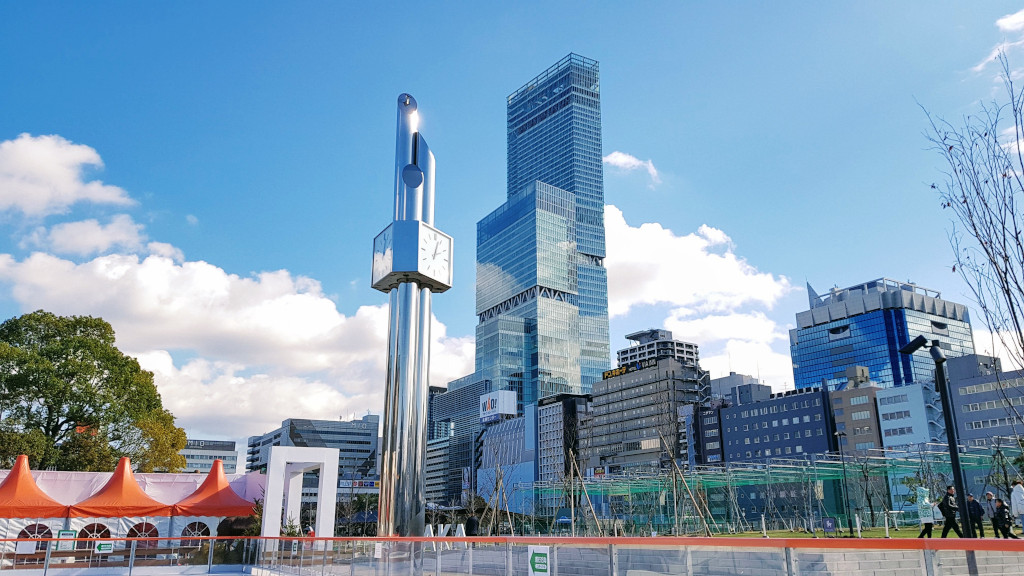
ABENO HARUKAS in Osaka - Japan's second tallest skyscraper
At the southern boundary of Osaka City (but still within Osaka Prefecture) sits Sakai.
On the face of it, Sakai feels like a modest suburb of Osaka. But it has been inhabited since 8,000 BC, and is where Daisen Kofun, the largest megalithic burial mound in the world is located.
Whilst the ancient capitals of Kyoto, and the even older Nara, are essential for anyone interested in immersing themselves in Japan’s bountiful Shinto shrines and Buddhist temples, Kansai offers equally important and impressive sites but in spots far less well-travelled.

Koyasan: one of Japan's centres of Buddhist study and practice
It is perfectly possible to pursue any interest in religious history or architecture and not have to visit Kyoto or Nara. Koyasan, in Wakayama Prefecture, is a centre of Buddhist study and practice, known for its religious pilgrimages.
The Kansai region includes two of Japan’s most iconic castles: Osaka and Himeji. Osaka-jo is a modern, but still imposing, reconstruction. Whereas Himeji-jo, Japan’s largest castle, survives intact as one of a few originals.
If you’ve only seen one photo of a Japanese castle, there’s a good chance it was of one of these two.

Himeji Castle is still guarded by samurai warriors!
The elegant port city of Kobe, nestling between the Rokko mountain range to its north and Osaka Bay to its south, is one of Japan’s most cosmopolitan destinations. Having opened up its port to foreign trade in 1868, Kobe has since welcomed foreign visitors, many of whom set up home here.
A few kilometres north of Kobe, tucked away deep in the folds of Mt. Rokko, lies Arima Onsen - one of Japan’s oldest natural hot-spring resorts.
The spa town’s healing gold and silver spring waters have been an attraction for the wealthy and the famous, plus more humble day trippers, since the 7th century.

Kobe Harborland - Instagram heaven
Further along the coastline, on the western outer fringes of Kansai, you’ll find the slightly outlying Himeji. What it lacks in close neighbours is more than made up for in its stunning, and largely intact original, castle.
Miraculously, despite 63% of the city being destroyed by bombing by the United States during World War II, the castle survived, leading to many locals believing it to be divinely protected.
A Week in Kansai - Itinerary Ideas
Let's take a closer look at how you can spend a week in Kansai and not visit Kyoto.
Kansai is a big region with a lot of diversity, so a comprehensive look at all the destinations worth your time is beyond the scope of this article. However, it makes a lot of sense to use Osaka as the base for any Kansai itinerary.
Osaka sits in the heart of the region and there's plenty to see and do in and around Osaka - all of which is no more than 1 hour by public transport.
OSAKA
Population: 2,668,586 (city) / 19,302,746 (metropolitan area)
Signature Food: Takoyaki, Okonomiyaki, Kushikatsu
Theme Park: Universal Studios Japan (USJ)
Recommended: Osaka Castle, ABENO HARUKAS, Shinsekai, Shitenno-ji Temple
Where to Stay: Hotel Nikko Osaka, Hotel Vischio Osaka by Granvia
Osaka: A city that will stimulate your curiosity with brilliant colours

Be sure to visit Shinsekai to immerse yourself in the real Osaka
Osaka has a lot to offer, so I suggest allowing up to three days out of your week to be here.
DAY 1 - Ideas
For a less-conventional immersion into the real Osaka, drop off your luggage at your accommodation (both Hotel Nikko Osaka and Hotel Vischio Osaka are centrally-located and recommended) head over to the downtown area of Shinsekai.
Shinsekai - Immersion In The Real Osaka
A gaudy mix of big, colourful street advertising, cheap bars, cheap restaurants, cheap clothes shops, pachinko parlours, a zoo, and the retro Tsutenkaku Tower, Shinsekai has a reputation for roughness (somewhat overplayed by the locals), but is packed with character.
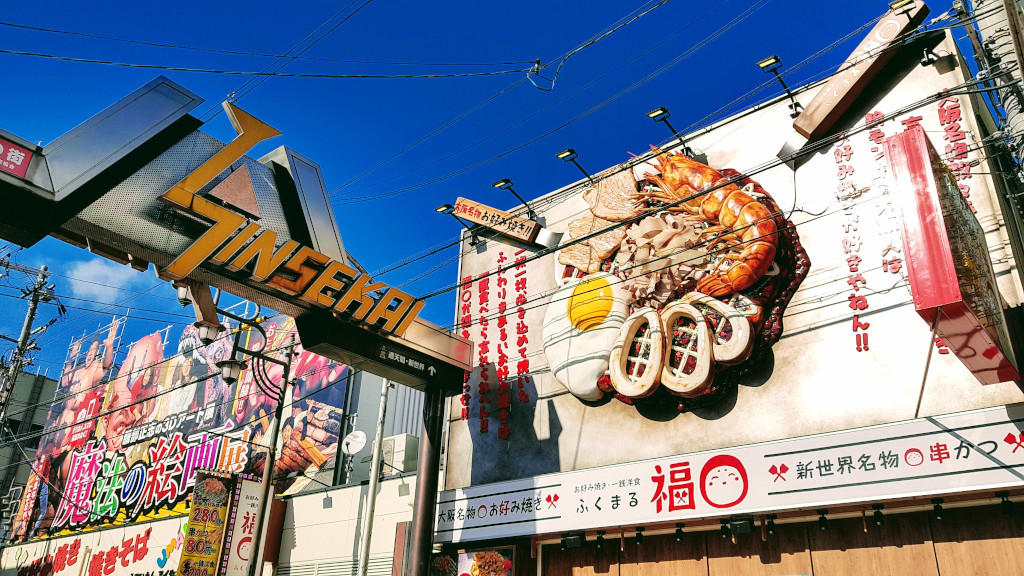
Shinsekai - a gaudy mix of colourful advertising and cheap restaurants
Use your common sense and you'll have nothing to worry about.
For a quick, cheap lunch try sampling the local speciality kushi-katsu (deep fried skewers). There are plenty of specialised restaurants to choose from, with prices typically around ¥80 (US$0.77 / £0.60 / AU$1.20) per stick. Sometimes even less.
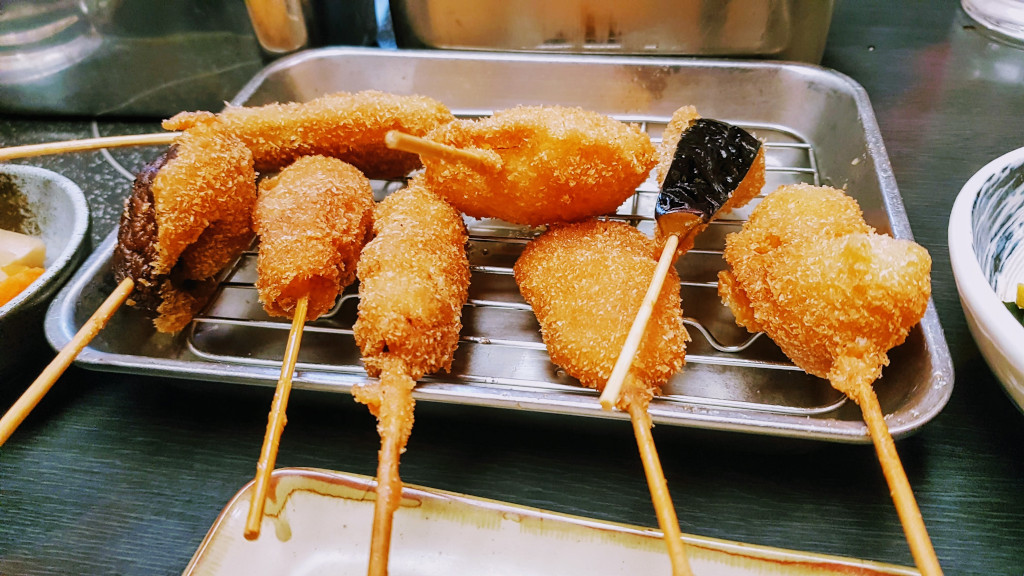
Kushikatsu (deep fried skewers) is one of Osaka's signature street foods
From one of Osaka’s least developed districts, it’s only a short walk around the perimeter of Tennoji Park to one of its most modern developments - the Abenobashi Terminal Building.
ABENO HARUKAS - Japan's Second Tallest Building
Here, alongside Osaka Abenobashi Station and Kintetsu department store, you find the stunning ABENO HARUKAS skyscraper.

ABENO HARUKAS in Osaka is Japan's second tallest building
At 300 meters tall and with 62 floors, it is the second tallest building in Japan. Views from the 62nd floor are impressive enough (to say the least).
But pay an additional 500Yen to gain (limited first-come, first served) access to the rooftop helipad for the most incredible unrestricted views across greater Osaka.
BOOK ABENO HARUKAS 300 Observatory Tickets HERE.
VIDEO: Japan's Second Tallest Skyscraper - Glass Elevator to 60th Floor
BOOK ABENO HARUKAS 300 Observatory Tickets HERE.
Head north to Namba, less than 10 minutes on the Midosuji metro line, to explore the area around Shinsaibashi, including Shinsaibashi-suji Osaka’s largest shotengai (covered shopping arcade).

America-mura is a centre for Osaka's youth culture
From the hip, art-covered streets of Osaka’s youth culture centre Amerika-mura (‘America village’), to the flagship stores for the world’s largest luxury brands, and with cafes dotted everywhere, it’s ideal for exploring on foot at your own pace.

Osaka's Dotonbori entertainment district at night is a feast for the eyes
For dinner, Dotonbori is only a 5 minute walk from Shinsaibashi. It is one of Osaka’s most popular tourist destinations but that’s part of it’s attraction.
Especially at night time when its bustling streets and the Dotonbori canal reflect the large and often outlandish illuminated and moving signs and billboards.
Discover Dotonbori Food Tours
Foodie tours, bar hopping, night walks, street food, sake tasting
You’ll be spoilt for choice of local favourites including takoyaki, okonomiyaki, udon and crab.
If you want somewhere convenient (but quiet) to stay close to Dotonbori, I can recommend Hotel Nikko Osaka. It's directly connected to Shinsaibashi Subway Station and is also located directly across the street from Daimaru Department Store.
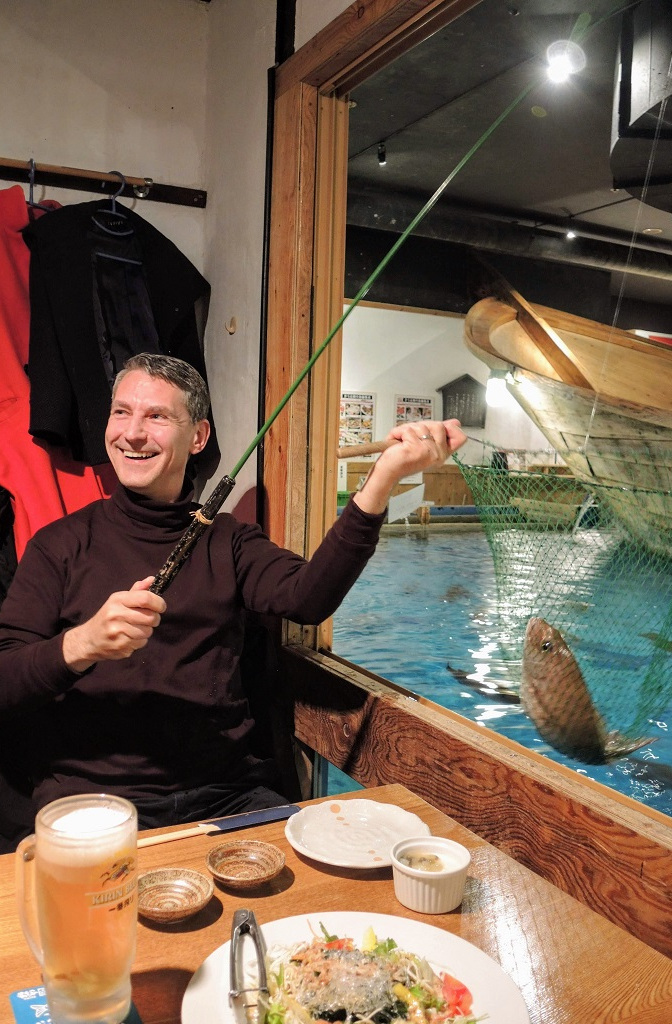
At restaurant Zauo you literally fish for your food
If you’re not squeamish, try your hand at literally fishing for your supper at the quirky Zauo restaurant.
Novelty aside, the quality of the sashimi or deep fried platters they produce from your catch is surprisingly good.
BOOK a Table at Zauo HERE.
DAY 2 - Ideas
Head over to Osaka Castle early first thing to beat the worst of the crowds.
Osaka Castle: A Japanese Icon
Since the castle is a modern reconstruction this makes it more accessible than it’s older counterparts - they’ve even installed an elevator meaning even wheelchair users can go inside and head to the top floors.
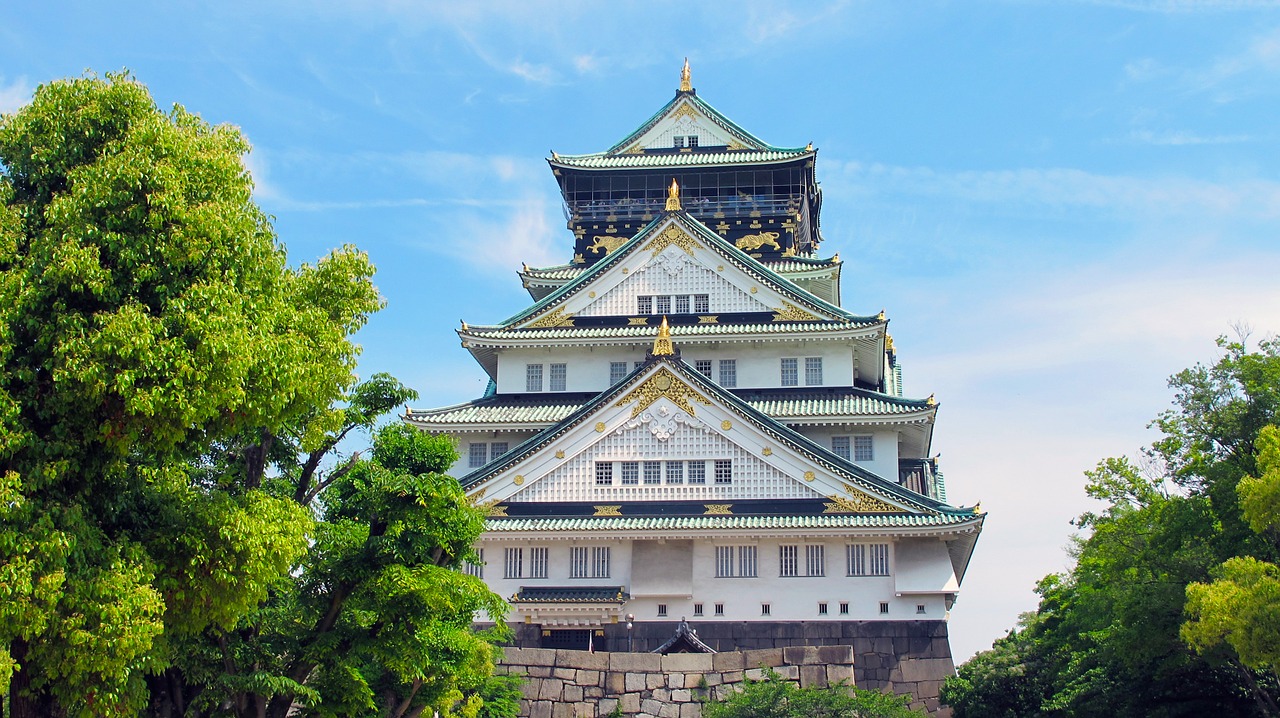
Osaka Castle - a Japanese icon
Due to the modern reconstruction, the interior of the castle is less essential to see than its exterior. It’s from outside, in the surrounding grounds, that it is seen at its best.
Thousands flock here during cherry blossom season which is a beautiful natural sight to witness if you can.
Discover Osaka Castle
Castle tickets, walking, cycling, private, photography tours
Becoming A Samurai or Ninja
Those looking for some fun can try out the Miraiza Osakajo Samurai or Ninja Experience, where you get to dress and train as either a samurai or ninja.

Dress as a samurai for the perfect souvenir photo in front of Osaka Castle
After receiving instruction on the moves you learn some choreography before filming a fight sequence, complete with music and added sound effects. Good fun for kids and big kids alike!
TRJ Tip:
training in the costume can get very warm - so remove plenty of layers before getting into costume and you’ll appreciate it later!
VIDEO: Samurai Training Experience at Osaka Castle
Okonomiyaki For Lunch
For lunch, sample one of Osaka’s signature dishes, okonomiyaki, at the famous Osaka Botejyu restaurant.
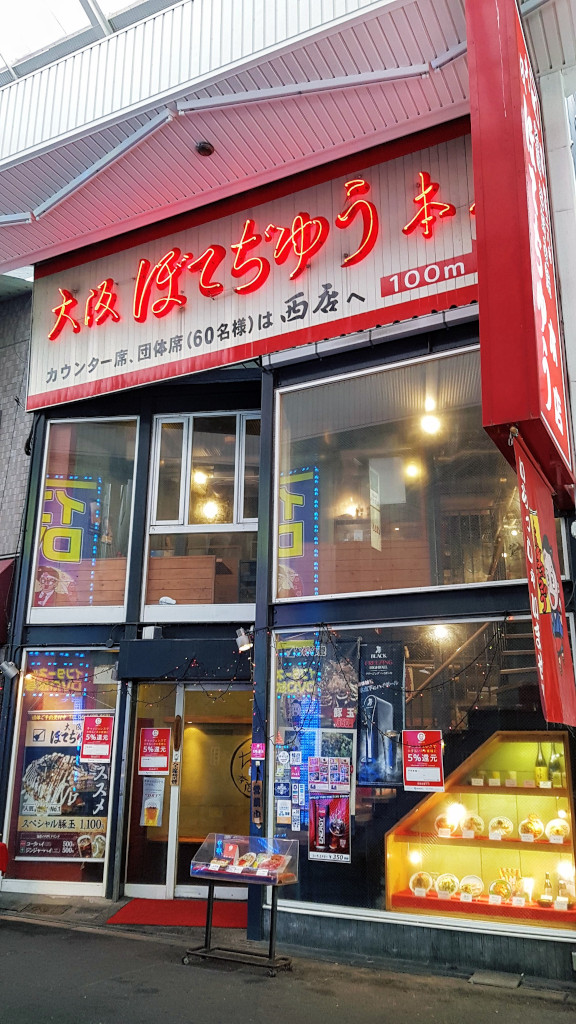
Famous Okonomiyaki restaurant Osaka Botejyu opened in 1953
Founded by Mr and Mrs Nishino, it first opened its doors in 1953 and was the first okonomiyaki restaurant to offer counter service where you can watch the chef prepare the dish right in front of you.
They were also the first to introduce mayonnaise and mustard to the recipe in a bid to attract more female diners. There’s even a manga published about the owners and the rise of their restaurant.
Oh, and the okonomiyaki is really good too.

ABENO HARUKAS, Japan's second tallest skyscraper, can be seen from a distance
If shopping is your thing, then head for Grand Front Osaka in the bustling Umeda entertainment district for an almost overwhelming selection of tax free shops, restaurants, cinemas and high-end concept stores.
The modern Hotel Vischio Osaka is conveniently close to Grand Front Osaka and and has an excellent Italian restaurant.
If that’s not your bag, then Osaka Station City - a vast complex of stores, restaurants, bars, cinemas, etc. that surround Osaka Station is well worth exploring. Ride the escalators up to the 12th floor, head onto the roof, walk through Japanese gardens before strolling around the rooftop farm!
From up here you get great views over to the stunning Umeda Sky Building. Take some photos from here before heading over to it, a short 10 minute walk from the station.

Osaka's Umeda Sky Building is a stunning building, especially at night
Umeda Sky Building: 360-Degree Views of Osaka
Umeda Sky Building is one of Osaka's most instantly recognisable structures.
It looks just like a ginormous version of the type of building I used to make out of Lego as a kid. It's two 40-storey towers that are joined at the top by escalators and a circular observation deck.
Take the glass elevator up to the Floating Garden Observatory, 170m above the ground, and take in the 360-degree views of Osaka.
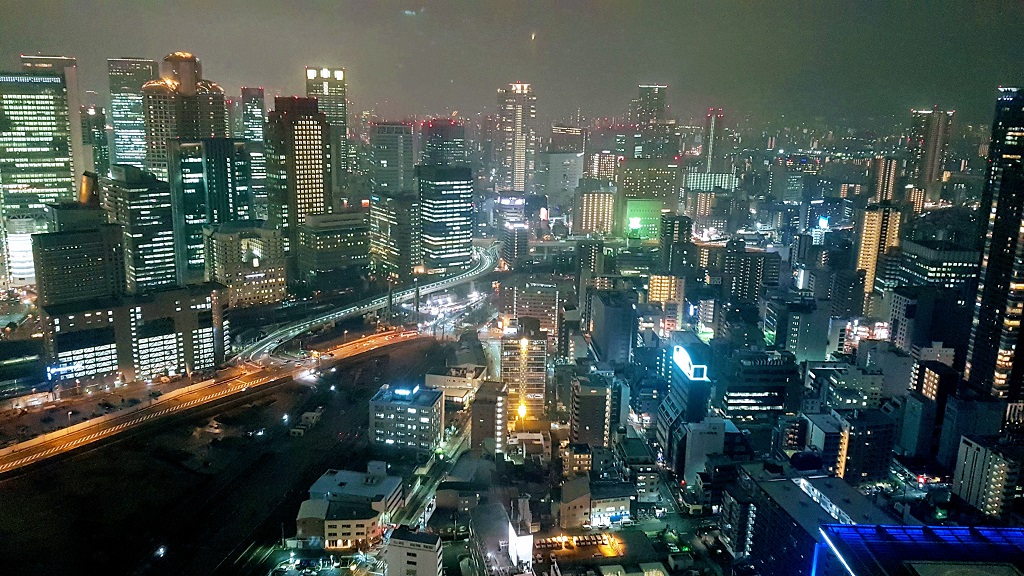
Osaka night skyline seen from Umeda Sky Building
The views are particularly noteworthy (and photogenic) at night when Osaka’s brilliant lights are at their most impressive. Tickets for Umeda Sky Building are good value at 1,500Yen, around 11GBP, 14USD, 21AUD.
If you don't want to waste time queueing for tickets on the day you can pre-book them in advance. Just buy, download, print and show yours to get in. It's open 9 am – 10:30 pm every day. Last entry 30 minutes before closing.
There’s also a retro, Showa-styled restaurant street in the underground level below the tower that’s good for a drink or bite to eat.
BOOK Tickets to Umeda Sky Building HERE.
DAY 3 - Ideas
Universal Studios Japan
Universal Studios Japan overlooking Osaka Bay is the 4th most visited theme park in the world. An impressive statistic when you consider it’s a fraction of the size of it’s more famous USA cousins. But then size isn’t everything.

The Wizarding World of Harry Potter at Universal Studios Japan in Osaka
I come here every few years just to revisit some of my favourite rides and attractions and to sample the new ones that open. There are also plenty of limited run and seasonal attractions, often unique to this park. Many are based on popular Japanese manga, anime or video games.
Although not vast in scale, you’ll be hard pushed to see all you want to see in a single day. So pre-planning (and booking) your visit is crucial to ensure you make the most of your time here.
BOOK Tickets to Universal Studios Japan HERE.
Getting Priority Access To Your Favourite Rides
Invest in an Express Pass to minimise queuing and to get priority access to your favourite rides and attractions.
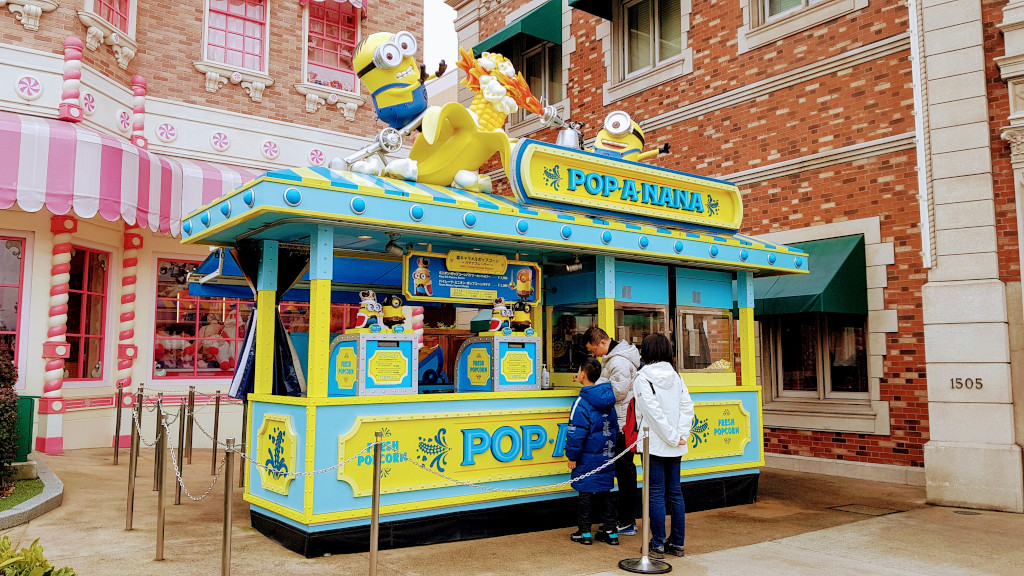
Minion Park (at USJ) has some hilarious attractions and sells banana flavoured popcorn!
Read my Ultimate Guide to Universal Studios Japan for advice on planning your visit and the best ticketing options and prices, with links to book your tickets in advance.
The Wizarding World of Harry Potter and the Minion Park are very popular and include some of the best rides the park has to offer. For those brave enough (not me) the Flying Dinosaur sees riders essentially hanging upside down on a rollercoaster that twists its way around the Jurassic Park area.
You can pre-order Studio Pass tickets and Express Passes on the Klook website HERE.
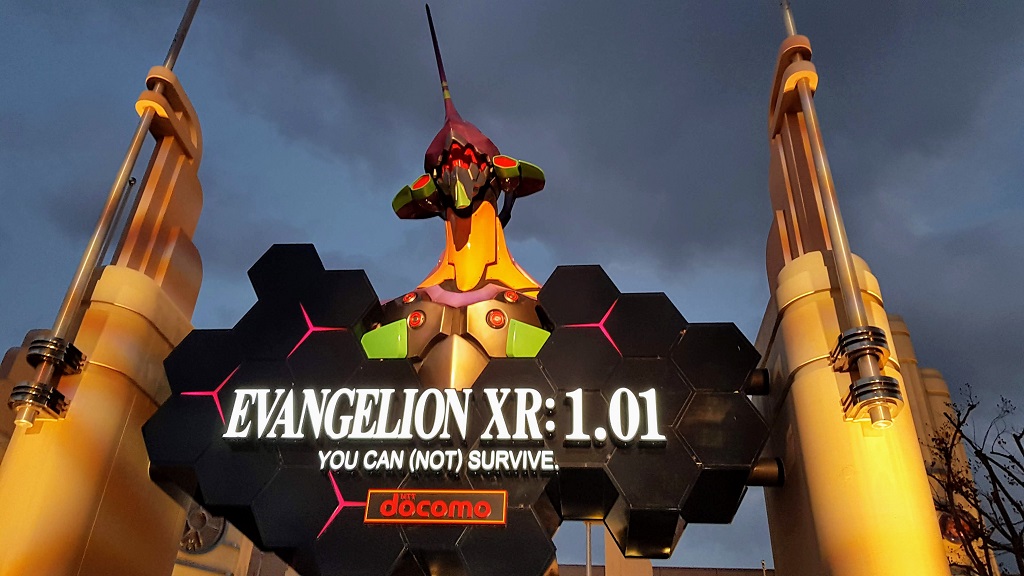
Universal Studios Japan regularly features limited run attractions like this Evangelion XR: 1.01 ride
If you like rollercoasters but not the idea of twisting around upside down at high speed in a confined space, then check out the Hollywood Dream - The Ride roller coaster running between two sides of the park above the streets below.
There’s another version, called Backdrop, that does a similar run but backwards and with a 43m backward dive.
BOOK Tickets to Universal Studios Japan HERE.
World's First Super Nintendo World
Super Nintendo World opened at Universal Studios Japan in February 2021.

Nintendo properties are trademarks and copyrights of Nintendo. © 2016 Nintendo properties are trademarks and copyrights of Nintendo.
It is the world’s first Nintendo Themed Area - developed at a cost of more than 50 billion yen. While USJ is the first location to open, Nintendo themed areas are also coming to Orlando and Hollywood.
Super Nintendo World features characters and themes from the Super Mario series of video games. The attraction also includes a variety of other globally popular Nintendo characters.
BOOK Tickets to Universal Studios Japan HERE.
VIDEO: Super Nintendo World Official Trailer
So expect the park, and the Super Nintendo World area in particular, to be filled with fans wearing Mario and Luigi red and green hats!
If you want to stay close to Universal Studios Japan then we have a handy list of suitable hotels (and a hostel) HERE.
FOR THE LATEST, READ: Universal Studios Japan: The Ultimate Guide
BOOK Tickets to Universal Studios Japan HERE.
KOYASAN
Landscape: A highland valley surrounded by mountains
History: Headquarters of the Shingon sect of Buddhism since 9th century
Stay: Shukubo (Buddhist temple lodgings)
Must See: Danjo Garan monastic complex, Okunoin Cemetery, Tomb of Kobo Daishi
Good to Know: Credit cards are not accepted at shukubo
Resource:
Koyasan Accommodation Google Map
Koyasan: If nature indeed brings mankind closer to the cosmos, then Koyasan is its embodiment
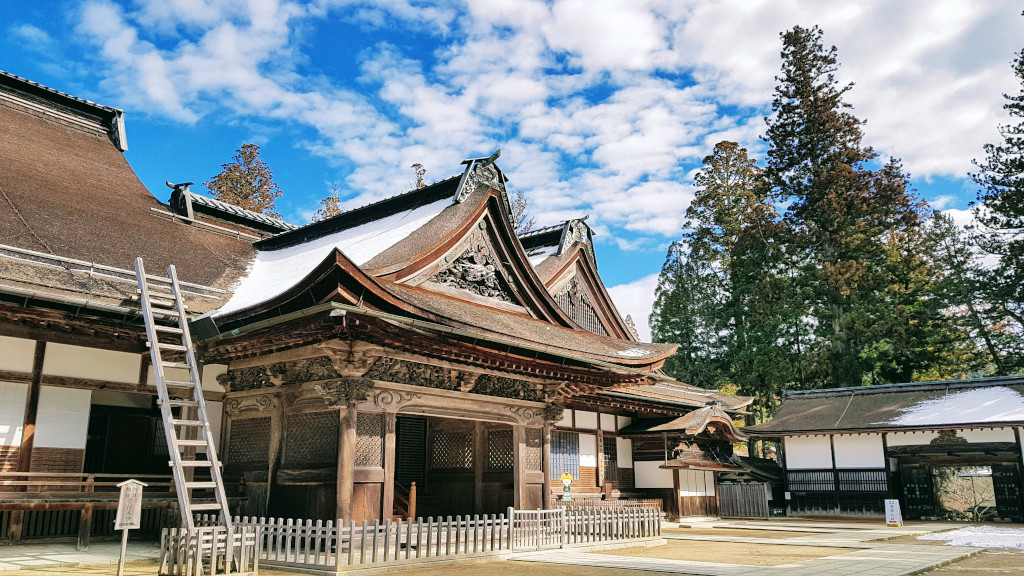
Kongobuji - the head temple of Koyasan Shingon Buddhism
A Peaceful Mountain Retreat
If it’s more of a peaceful mountain retreat you’re after then they don’t come much more authentic than staying in a shukubo (Buddhist temple) in Koyasan in Wakayama Prefecture.
It feels like another country compared with Osaka, and yet it’s only an hour and a half away by train.
LIVESTREAM: Exploring Koyasan Buddhist Sanctuary at Night
Getting To Koyasan
A great side trip from Osaka is to grab yourself a Nankai Electric Railway All Line 2-Day Pass, leave in the morning, travel to and stay in the beautiful Koyasan for one night, before heading back to Osaka the following day.

For Koyasan, catch the Nankai Express from Osaka to Gokurakubashi Station
If you do already have plans to stay in Kyoto and Koyasan grabs your interest then it is possible to book a one day Mount Koya tour from Kyoto. Also, you might want to check out these hidden Kyoto walks to explore the city off the beaten path a bit.
Nankai runs Limited Express trains out of Osaka’s Namba Station, taking an hour and a half to get Gokurakubashi - at the end of the Nankai Koya line. From here take the Koyasan Cable Car up to the top of the mountain to arrive at Koyasan itself.
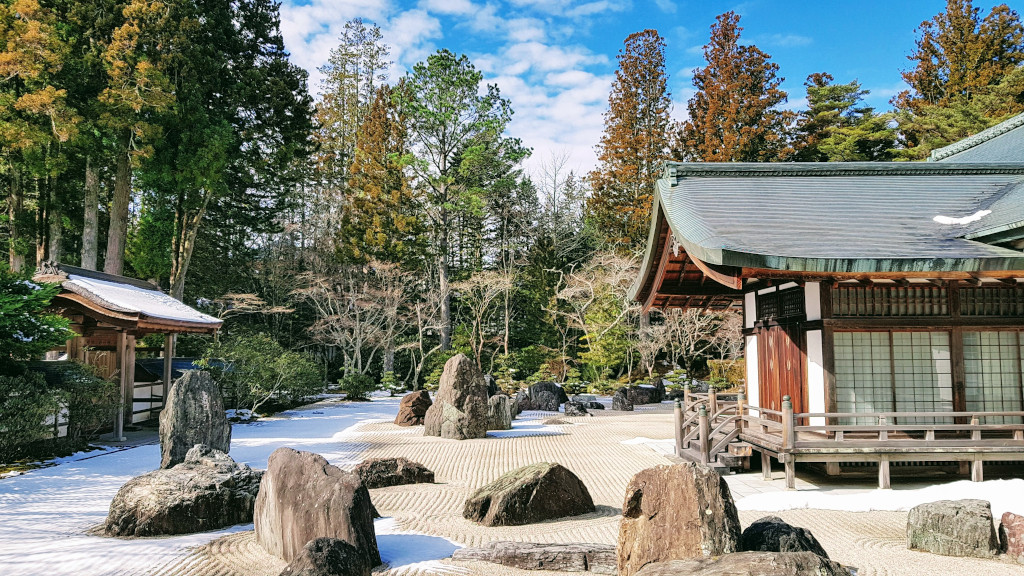
Banryutei - Japan's largest rock garden inside Kongobuji Temple
Before the monk Kukai put this holiest of locations on the map early in the 9th century, Mt. Koya was just another remote, tree-covered mountain in Japan’s dense rainforests in the Kii Peninsula.

Konpon Daito (Great Pagoda) planned by Kobo Daishi as the centre of the monastic complex
Over 100 Buddhist Temples
Since Kobo Daishi (the posthumous name for Kukai) founded it in 819, it became the headquarters of the Shingon sect of Buddhism, built around a huge temple settlement of more than 100 temples and sub-temples.
Discover Koyasan Tours
Day, private, walking, multi-day, and temple lodging tours
Many of the temples happily offer lodging both to pilgrims and to less-devout travellers. Called shukubo, temple lodgings are not too dissimilar to their better-known secular counterparts ryokan.
There are some 52 shukubo in Koyasan and the most authentic way to experience this most magical of places. To help with booking your accommodation in Koyasan, I've created a free Koyasan Accommodation Google Map.
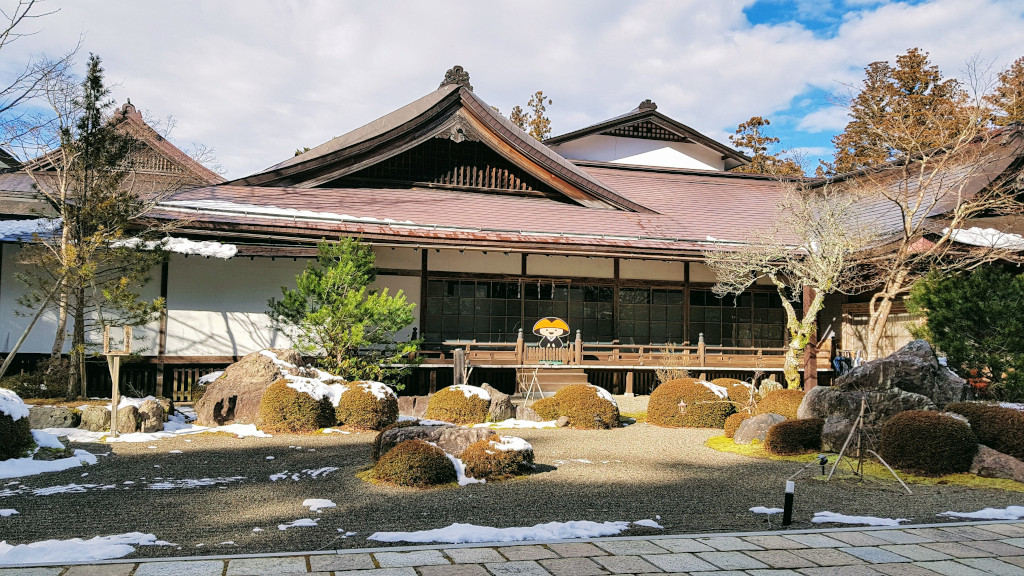
Henjosonin Temple - a shukubo (Buddhist Temple lodging)
In 2004, Mt. Koya was awarded UNESCO World Heritage Site status, along with Yoshino and Omine and Kumano Sanzan, two other locations on the Kii Peninsula, as "Sacred Sites and Pilgrimage Routes in the Kii Mountain Range".
I stayed at the Henjosonin Temple shukubo temple lodging.
VIDEO: Shingon Buddhist Meditation at Henjosonin Temple
BOOK a Stay at a Buddhist shukubo temple, Koyasan HERE.
HIMEJI
Population: 530,517
Access: 16 minutes from Kobe by shinkansen
Stay: Daiwa Roynet Hotel
Ride: Himeji Castle Loop Bus
Must See: Himeji Castle
Himeji: A dazzling city of history and traditional culture

The stunning Himeji Castle - also known as the White Heron Castle
Japan's Finest Castle
With over 400 years of history, Himeji Castle is often cited as Japan’s finest castle. It’s a stunning example of Japan’s unique castle structure in near-entirety. The might and beauty of its wooden construction is rightly recognised by UNESCO as a World Heritage Site.
Because of the gleaming white exterior of its walls, and their distinctive sweeping curves of its gable ends, Himeji is also known as the ‘White Heron Castle’. Although the main keep appears to have five stories there are actually seven floors inside including a basement.
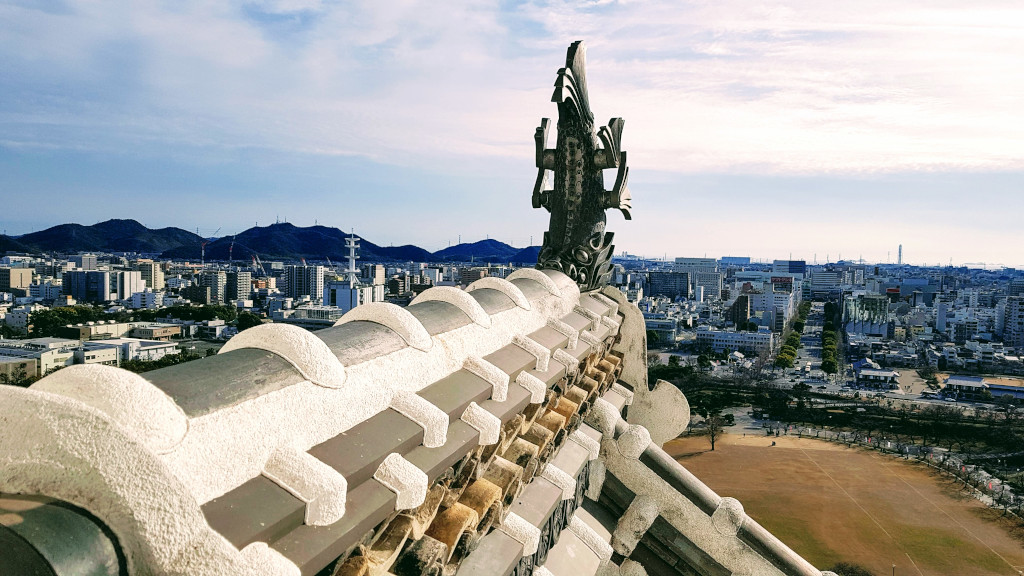
Views out across Himeji City from the top of Himeji Castle
Tom Cruise and James Bond Filmed Here
It was also recognisably used in the filming of the Tom Cruise epic The Last Samurai and the Sean Connery James Bond film You Only Live Twice. Allow extra time to explore the extensive 83-building complex surrounding the castle.
I’ve been here several times and of all the Japanese castles I’ve seen it remains the most impressive. Not only is it huge (it’s Japan’s largest castle) but it is also majestic. Well worth building into any itinerary.
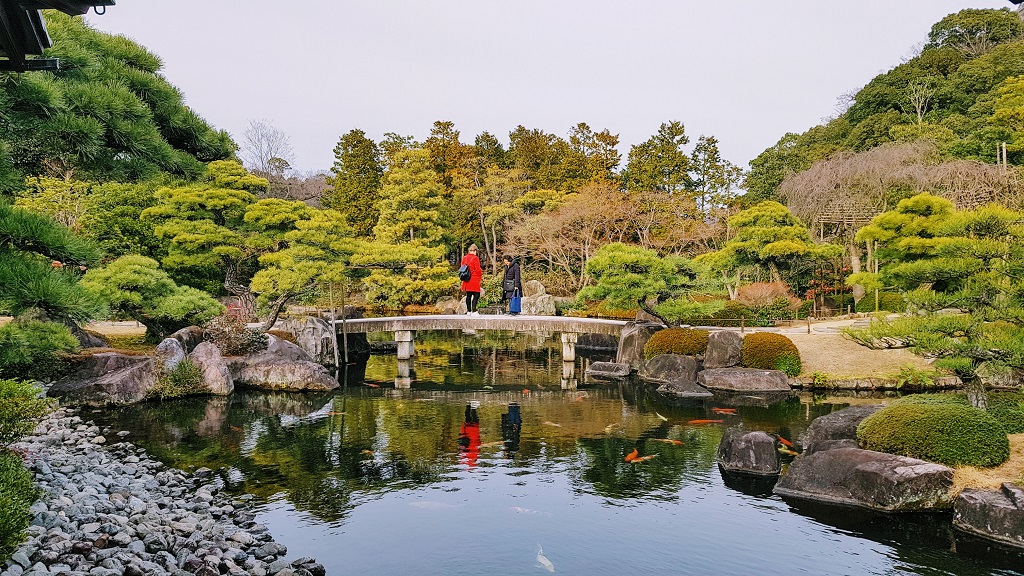
KoKoen Garden can be found next to Himeji Castle
KoKoen Garden, Museum of Literature, Nagoyama Stupa
Several other points of interest can be found nearby including Kokoen Garden (right next to the castle), Himeji City Museum of Literature (designed by leading Japanese architect Tadao Ando), Nagoyama Stupa (where the ashes of Buddha are stored) and the Japan Toy Museum which houses over 90,000 items.
The retro-styled Himeji Castle Loop Bus is a convenient way to see the area around the castle. Show the One Day Himeji Tourist Pass for discounts at certain spots.
There's a good choice of hotels in Himeji, but the Daiwa Roynet Hotel gets the balance of style, location and price just about right for most people.
SEE ALSO: Himeji City Guide: Secret City of Sake, Swords and Samurai
SAKAI
Population: 828,741
Famous Residents: Sen no Rikyu (tea master), Yosano Akiko (poet)
Souvenir: Sakai knives
Eat: Eel tempura at Umigokochi
Must See: Daisen Kofun, Sen no Rikyu Chanoyu Museum, Sakai knives
Sakai: Massive 5th century tombs to rival the pyramids

Sakai harbour overlooks Osaka Bay
On Osaka City’s southern boundary, and overlooking Osaka Bay out to Kansai International Airport, Sakai has been one of Japan’s most important seaports since Medieval times.
Sen no Rikyu - Japan's Grand Tea Master
Grand tea master, and founder of the Senke family of tea ceremony schools, Sen no Rikyu was born in Sakai.
The outstanding new Sen no Rikyu Chanoyu Museum is a great place to learn more about this much-revered man, and houses exhibits, films, a tea room where you can experience a casual and truncated version of the tea ceremony.
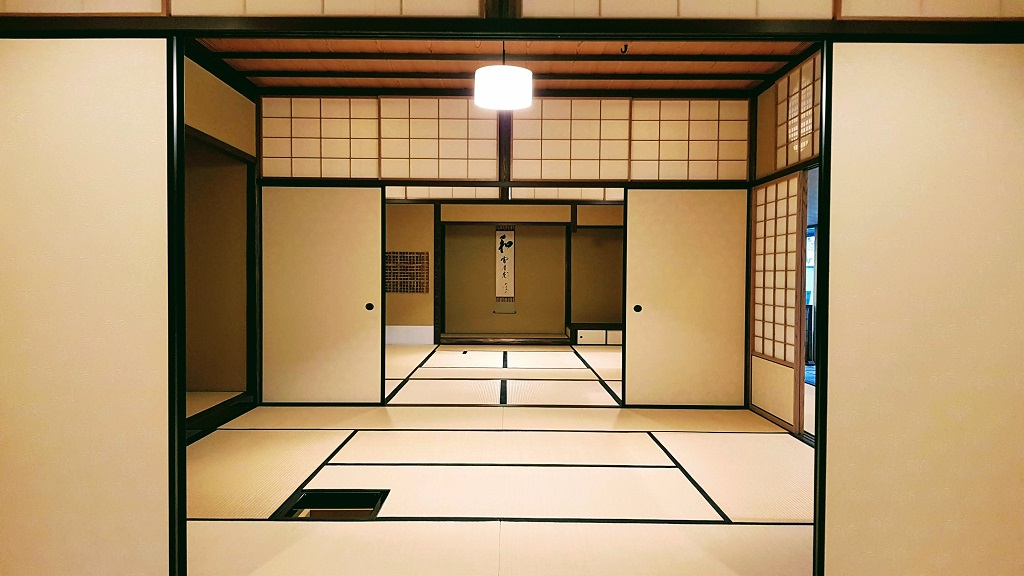
Learn about Japan's grand tea master at Sakai's outstanding Sen no Rikyu Chanoyu Museum
In addition, it contains exhibits about Yosano Akiko, a female poet, also born in Sakai, active during the Meiji and Showa periods and houses the Sakai tourist information centre.
Daisen Kofun - The World's Largest Grave
The city is best known for its keyhole-shaped kofun burial mounds dating from the 5th century. The largest, Daisen Kofun, is thought to be the resting place of the Emperor Nintoku and the largest grave in the world.
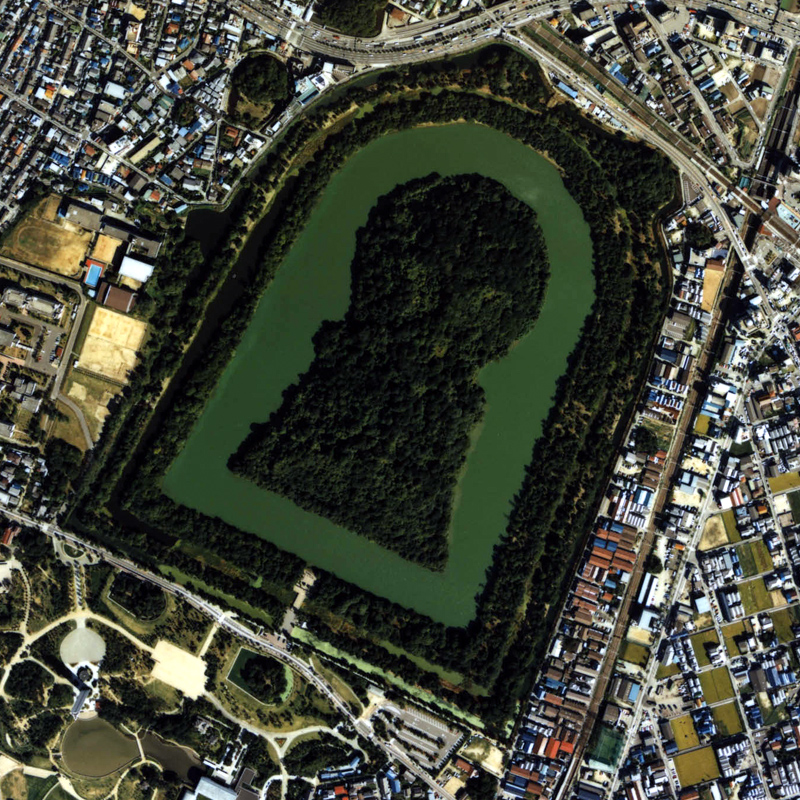
Daisen Kofun as seen from the air. Copyright © Ministry of Land, Infrastructure, Transport and Tourism of Japan
Although the tomb is said to be one of the world’s three largest tombs, along with the Great Pyramid of Giza and China’s Mausoleum of the First Qin Emperor, at ground level there’s not a great deal to see.
To get a better sense of just how stunning the site is, head across the road to the Sakai City Museum, where there’s a large screen cinema and a virtual reality experience, with 360 aerial footage and CGI of how it looked when it was constructed.
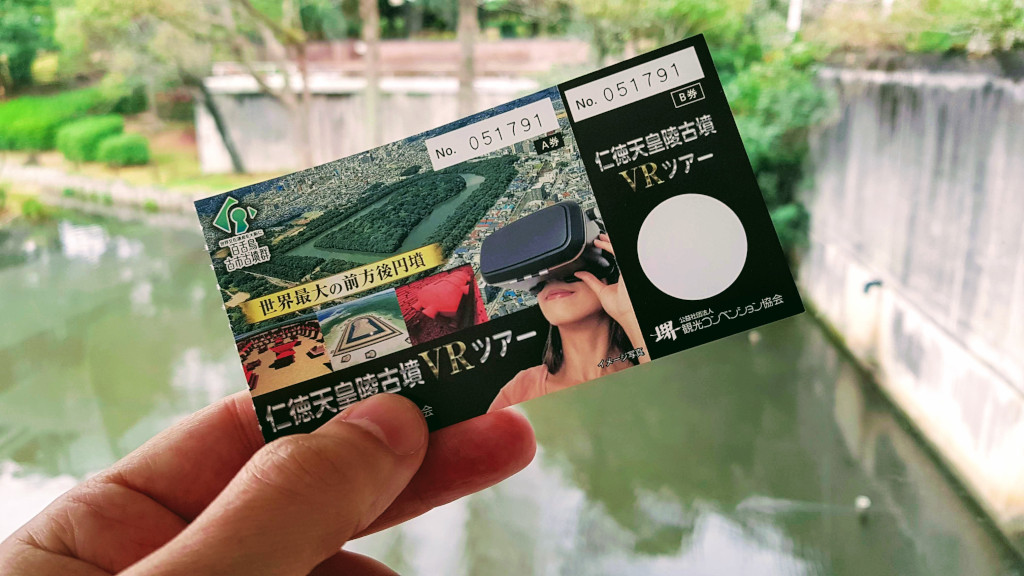
Virtual Reality experience of Daisen Kofun in Sakai City Museum
However, for the ultimate views, it is possible to take a helicopter or small plane tour over multiple ancient tombs spread across the city, including Daisen Kofun. Several tours offer a comprehensive 360 degree view of the site. A full list of the top Osaka air, helicopter & balloon tours can be booked on the Viator website HERE.
Hanachawan - Unique Kofun-Shaped Curry
For a spot of fun after all that culture, why not pop into Hanachawan for a unique lunch of curry rice - kofun style. Here the mamma-san serves up a variety of fragrant curries - all in the distinctive keyhole shape of the kofun.
And the cutlery is a spade and a fork!

Hanachawan in Sakai serves kofun-shaped curry rice!
Japanese Knives - Sakai Home of Japan's Knife Tradition
It’s no exaggeration to say that Sakai’s knives are renowned throughout the world for their outstanding quality. Once known for samurai swords, it’s now kitchen knives that are in high demand, and their production is a major industry in the city.
80% of Japan’s chefs use Sakai knives and they are cheaper here than anywhere else in Japan - as much as 20-30% cheaper. Head over to the Sakai Hamono Museum, where you can see the 165 types of knives for kitchen use, and pick up a bargain of your own.

80% of Japan’s chefs use Sakai knives
RELATED: Japanese Knives: 600 Years of Craftsmanship
For local foods, why not try your hand at making wagashi, traditional Japanese sweets at Cafe Sacay, where you can sample your handiwork with a warm cup of matcha tea.
A nice appetizer before heading over to Umigokochi for a dinner of eel tempura in this authentic izakaya, popular with the locals.
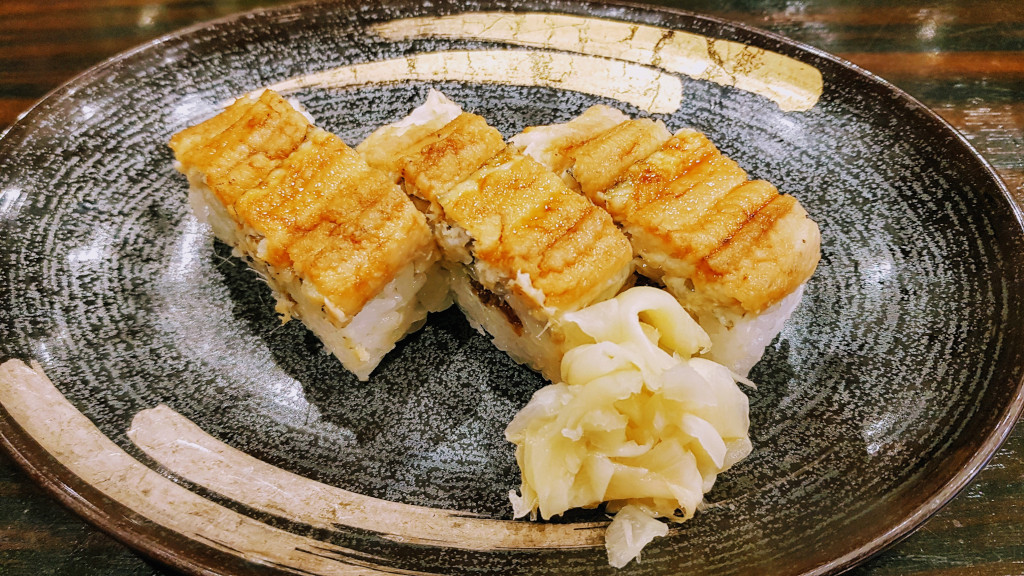
The eel sushi at Umigokochi is fantastic
The sushi here is just as high a standard and again the eel sushi is among the best you can taste anywhere in Japan. Recommended!
Because of its location (being so close to Kansai airport), Sakai is a good option to stay overnight on your last night in Kansai before flying out of KIX to your next destination.
Booking.com offers more than 30 places to stay in Sakai. I stayed at the Hotel Agora Regency which offers 5-star comforts at very reasonable prices.
BOOK a Stay at Hotel Agora Regency HERE.
KOBE
Population: 1,524,601
Explore: Mount Rokko
Must Try: Kobe beef, coffee, cakes
Stay: Kobe Meriken Park Oriental Hotel (5* luxury)
Experience: Harbour history, Ikuta Shrine, cafe culture, Luminarie light festival
Kobe: Modern architecture and cuisine, in a relaxing, elegant port city
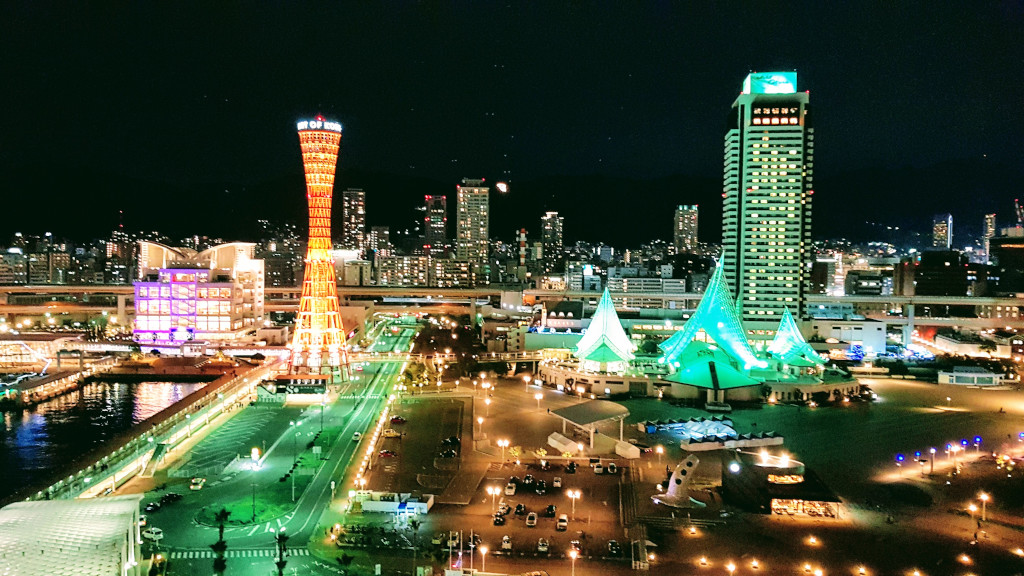
View over Kobe's Harborland district, a great place to walk around, day or night
DAY 1 - Ideas
Unlike many of its rivals, Kobe doesn’t boast a single, must-see landmark or attraction, rather it is a number of pleasant districts that reward casual exploration on foot.
These diverse areas include beaches at Suma, sake breweries in Nada, shopaholic and foodie paradise Sannomiya, historic former foreign settlement of Kitano, and the waterfront views of Harborland.
Cosmopolitan Elegance, Coffee and Jazz
There’s something undeniably elegant, sophisticated even about modern-day Kobe, no doubt a legacy of having opened its ports to international trade in the 19th century.

Kobe dazzling at night as seen from the Harborland waterfront area
This not only led to an influx of foreign goods and food (including coffee - a drink for which Kobe is now famous), but for Western culture too including jazz, football and movies.
And then there’s the world-famous Kobe beef too. Not to be missed!
The World's Second Longest Suspension Bridge
Also worth a short detour is the mighty Akashi Kaikyo Bridge - the world’s second longest suspension bridge in Akashi. The views from the top of its 289 metres high towers are nothing short of stunning.
It’s a short 30 minute local train ride west from Kobe.
Learn More: Exploring The World’s (Second) Longest Suspension Bridge – Akashi Kaikyo

Akashi Kaikyo, the world's second longest suspension bridge, is just 30mins from Kobe by train
Experience sake tasting at Sawa no Tsuru a brewery/museum, walk around the Sannomiya shopping, entertainment and restaurant district and take in Nankinmachi (Chinatown) and Ikuta Shinto shrine.
Harborland: Kobe's Most Instagrammable Spot
In the afternoon, head down to the Harborland area - a great place to spend a few hours walking and sampling the coffeehouses, restaurants and bars.
Instagram selfie opportunities abound here, with the Be Kobe sign, the emblematic red Port Tower (a symbol of the city), and the white, wave-shaped Kobe Meriken Park Oriental Hotel all providing striking backdrops.
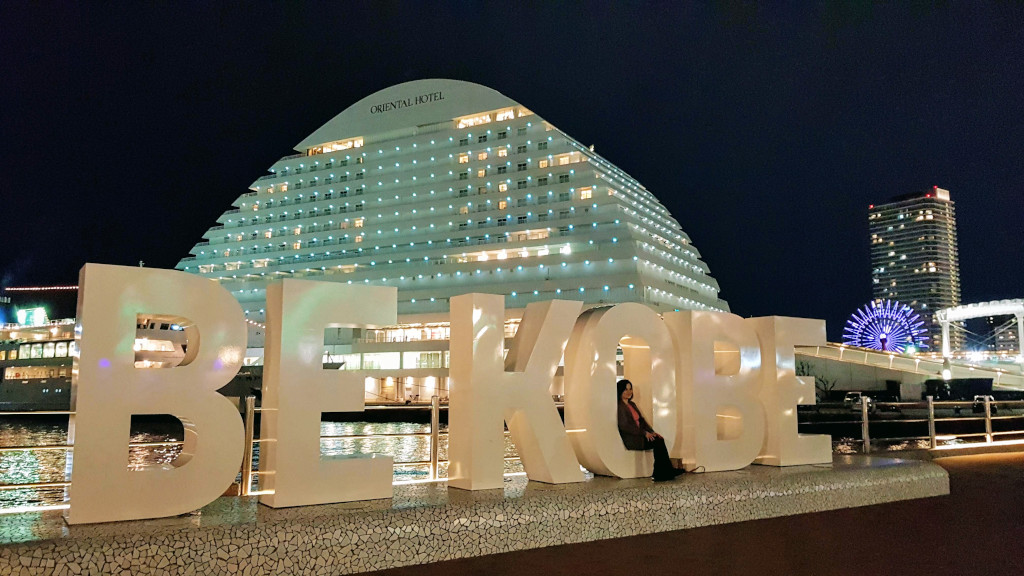
Kobe's Harborland is Instagram heaven
Where To Sample The Finest Kobe Beef
For the ultimate combination of theatre and fine food, make a reservation in the Kobe Meriken Park Oriental Hotel’s Steak House, where you can sample the world’s finest Kobe beef. Prepared in front of you by head chef Shota Kuwasaki.
There are few times most of us will spend upwards of 42,000JPY (390USD / 300GBP / 593AUD) on dinner per person.
But when those rare chances arise and the food, wine, service, location and ambiance all combine into a memory to last a lifetime, you take them and appreciate that life should, and can, give you incredible experiences such as this.
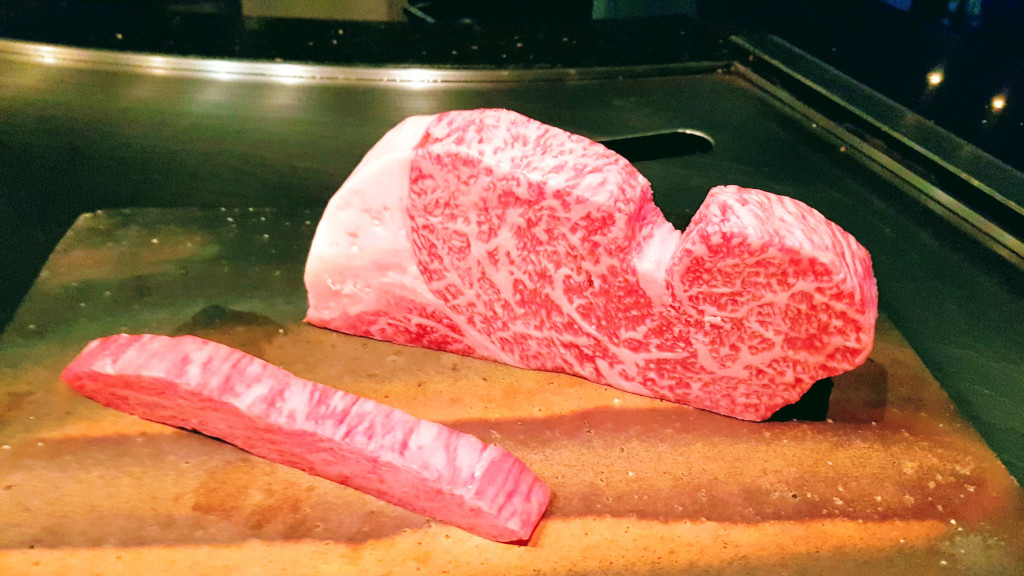
The kobe beef served at Kobe Meriken Park Oriental Hotel's Steak House restaurant is second to none
Take in the nighttime lights of Kobe and the MOSAIC Harborland shopping area whilst sipping over a cocktail or some fine Yamazaki whisky in the top floor View Bar and pretend you're in Lost in Translation.
Then head to your very comfortable room with balcony views over the Kobe city skyline.
BOOK a Stay at Kobe Meriken Park Oriental Hotel HERE.
DAY 2 - Ideas
If staying in Kobe for 2 days, or if you’re pressed for time, you can easily make it a single overnight and fit in Himeji in a haf day, here’s a few recommendations on how to spend your time.

The Takenaka Carpenter Tools Museum is Kobe's hidden gem
Kobe's Hidden Gem Is Not What You'd Expect
Unlikely though it is to appear on most visitors’ ‘must do’ lists, a visit to the beautiful Takenaka Carpenter Tools Museum rewards beyond its dusty-sounding name.
It's a masterclass in how niche subject museums can present their subjects. It’s the very definition of a ‘hidden gem’.
Top Things To Do In Kobe
Attractions, food, experiences, sightseeing, cruises
Housed, partly underground, the project and it’s striking architecture was designed and constructed by the Takenaka Corporation (Japan’s oldest carpentry construction company, founded in 1610) in collaboration with skilled woodworkers.
Learn More at the Official Takenaka Museum website HERE.
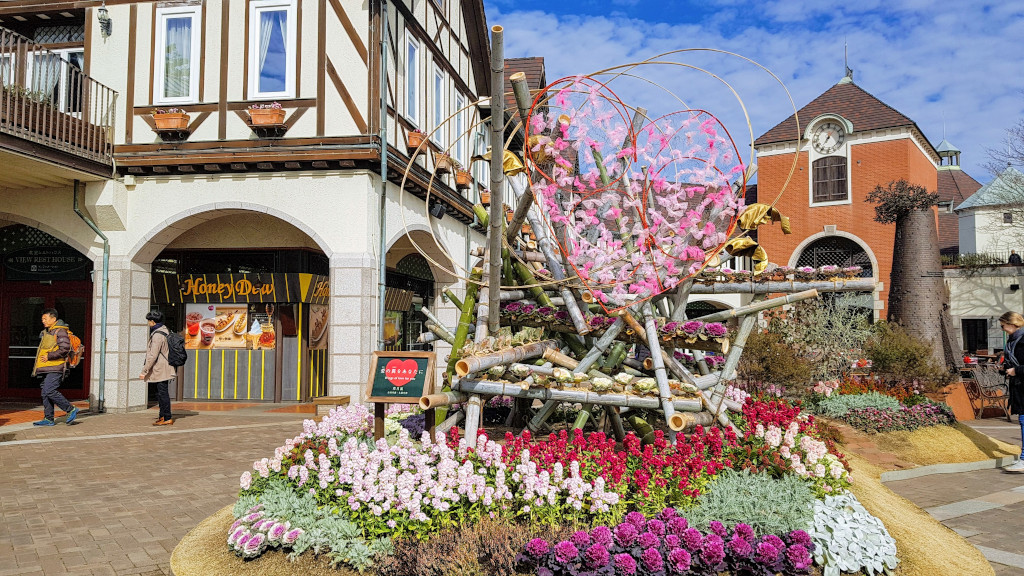
The Nunobiki Herb Garden on Mt. Rokko is definitely worth a visit when in Kobe
Mt. Rokko & Nunobiki Herb Gardens
No visit to Kobe would be complete without visiting Mount Rokko. The Nunobiki waterfall (which has important significance in Japanese literature and Japanese art) is a short walk from Shin-Kobe train station. Looking up from here you can see the gondolas of the Shin-Kobe Ropeway.
Take the ropeway and ride the gondolas up the mountainside and head for Nunobiki Herb Garden. Aside from the large botanical gardens (including Japan’s biggest herb garden) the views down to Kobe city below and out over Osaka Bay are spectacular.
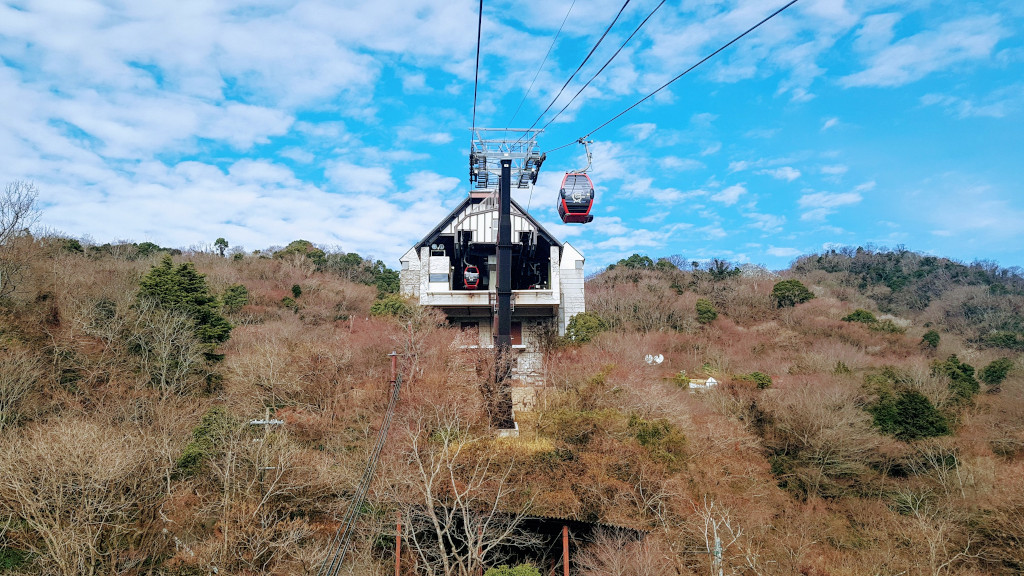
The cable car up to Nunobiki Herb Garden offers stunning views over Kobe and Osaka Bay
A restaurant with a veranda provides a pleasant spot to relax for a lunch made using the local herbs. Anyone interested in hiking should check out the marked routes up and down the mountain as invigorating alternatives to the (admittedly delightful) gondolas.
Top Things To Do In Kobe
Attractions, food, experiences, sightseeing, cruises
Kobe Luminarie Light Festival
The annual Kobe Luminarie light festival, held every December in memory of the Great Hanshin earthquake of 1995 which accounted for more than 6,400 deaths, is a must-see.
Authorities close off several streets in the heart of the city creating a route of tree lights and intricate light arches spanning the roads beneath.

If you're in Kobe in December then the Luminarie light festival is a must
The route always finishes in Higashi Yuenchi Park park where the celebrations include dozens of street food stalls.
This national event regulars attracts over 3 million visitors every year.
Learn More: Kobe Luminarie Light Festival
ARIMA ONSEN
History: Natural hot spring (onsen) resort since 7th century
Access: 40mins from Kobe by train
Stay: Arima Onsen Gekkoen Korokan
Souvenirs: Mineral bath salts, Arima cider, cosmetics, Tansan Senbei (sweet crackers)
Must See: Kin no Yu (golden) and Gin no Yu (silver) waters public baths, Yumotozaka street
Arima: Nurture body and soul surrounded by nature and hot springs
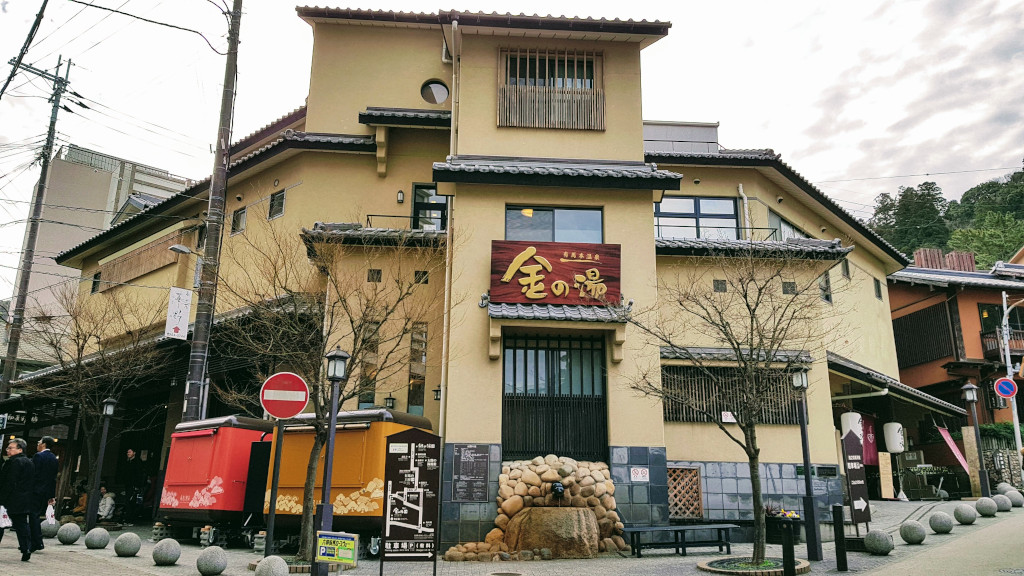
The healing waters of Kin-no-yu (Golden Hot Spring) contain iron, calcium and salt
Technically part of Kobe, Arima Onsen is a centuries old spa town in Mount Rokko - 20km northeast of the city. It’s long been the destination for wealthy travellers seeking respite in its healing waters.
These days, it isn’t only the rich and famous who come here, but a steady stream of overnighters and day trippers keen to sample its famous natural hot springs.

Be sure to stroll into the back streets of Arima, you'll find some memorable, but less-seen, sights
It’s no surprise that a series of onsen, ryokan and luxury hotels have been a constant feature down it’s centuries old history.
3 Backstreet Arima Stores You Should Visit
Be sure to build in time to explore Arima’s backstreets, as it’s here you’ll find a series of traditional, charming and sometimes quirky independent shops, cafes, and restaurants.
A few in particular are worth seeking out.

The handmade doll brushes at Arima Ningyo Fude make ideal souvenirs
Here's three recommendations:
Arima Onsendo also has a nice choice of T-shirts (which I succumbed to on a recent visit).

Private onsen at Gekkoen Korokan can be booked as part of a day experience or overnight stay
One unforgettable way to indulge yourself for an afternoon is to head to hotel Gekkoen Korokan for a memorable onsen experience. Here you can book a private onsen, either for yourself alone if travelling solo, or large enough for a family of 4 or more.
Having soaked in Arima’s famous healing hot spring water, head to their restaurant for a multi-course kaiseki cuisine lunch that’s as stunning on the eye as it is on the taste buds.

The multi-course kaiseki lunches at Gekko-en Korokan are served in private rooms
Where To Stay in Arima Onsen
Of course, Arima's well-established reputation means there’s no shortage of accommodation in the town. And they're not all at the high-end either.
Turn your day of indulgence into a luxurious overnight at the 5-star Gekkoen Korokan. They offer Japanese and western-styled rooms, including their 'Hollywood' room with open air bath.
BOOK a Stay at Gekkoen Korokan HERE.

Tea Salon Douka-Tei - one of Arima's many independent stores
If you’re on a budget or time-limited, you can still soak in the luxuries that Arima has to offer by simply making your visit a day trip and not staying overnight.
Access to Arima Onsen is easy, with train, road, bus and even ropeway via Mt. Rokko means you have plenty of options.
Getting To Kansai
The Kansai region is easily accessible by plane, bus, car, local and shinkansen (bullet) trains. A number of cruise ships also dock in Kobe as part of their itineraries.
Kansai International Airport (KIX) operates 24-hours and is the local international gateway to the region, seeing almost 8m foreign tourist arrivals per year.
Direct flights are available from the USA, Europe, Australia and Asia.

The modern Kansai International Airport operates 24/7
Built on an artificial island in Osaka bay and opened in 1994 it’s become the hub for low-cost carriers flying to Asia. It is located 40km (about 25 miles) southwest of Osaka. It’s also the nearest international airport to Kyoto.
Japan’s two biggest airports in Tokyo - Narita and Haneda - both have daily connecting flights to KIX.
VIDEO: The 'Giant Robot' Nankai Rapi:t Train
From here to get to the heart of Osaka, jump on the Nankai Express Rapi:t Train (which looks like a giant blue robot in train form).
It takes around 35 minutes, arriving at Namba Station - right in the middle of Osaka’s major entertainment centre.
BOOK Nankai Express Rapi:t Tickets HERE.
Alternatively, a taxi or bus will take around 40 minutes.
How to Travel in Japan Without Speaking Japanese
One of the major considerations with travelling in Japan is the inscrutable Japanese language.
A seemingly incomprehensible, often kaleidoscopic, barrage of cryptic symbols awaits the foreign traveller who doesn’t speak or read the language.
I’ve been exploring Japan since 2000 and I’ve picked up plenty of tips along the way.
I’ve distilled decades of my experience into this ebook for you.
This practical Guide and Workbook covers all the essential basics you need to ensure your first (or next) trip to Japan is as Amazing as you deserve it to be.
Where Will You Go In Kansai?
So, there you have it. A few suggestions as to how you can spend your week in Kansai.
Hopefully it has given you a some ideas as to where you will go in this richly diverse region and what to include in your own itinerary.
If you've been to Kansai and have your own recommendations, please share your own experiences with other readers by leaving a comment below.
Location Map

About the Author
A writer and publisher from England, Rob has been exploring Japan’s 6,800 islands since 2000. He specialises in travelling off the beaten track, whether on remote atolls or in the hidden streets of major cities. He’s the founder of TheRealJapan.com.
Resources
Further Reading
3 Hidden Kyoto Walks To Get You Off The Beaten Path
7 Extraordinary Things To Do In Himeji (Beyond The Castle)
11 Unique Things To Do in Osaka
Regional Japan Rail Passes: 5 Best Value Passes
Official Tourism Websites
Himeji Guide (JNTO)
https://www.japan.travel/en/destinations/kansai/hyogo/himeji-and-around/
Osaka Info
Official Travel Guide of Kobe
Visit Arima Onsen
https://visit.arima-onsen.com/
Sakai Tourism & Convention Guide
https://www.sakai-tcb.or.jp/en/
Koyasan - The Official Wakayama Travel Guide
https://en.visitwakayama.jp/destinations/koyasan/
Koyasan Accommodation Google Map
Japan Travel Guidebook
Learn More about my book How to Travel in Japan Without Speaking Japanese
If you enjoyed this article please share this online:



Rick,
Uhh, I mean Rob, you must be the Rick Steves of Japan! Great blog; good pics; nice recommendations. I have made use of them with a 4 – day stay in Osaka and a 1 day stay in Kobe at the recommended Hotel. As a Genius 3 with Booking, glad to get a confirmation of its value to you. In Nov 23, I used Light Pocket Wifi which worked moderately from my house in Izu Skyline near the now closed Izu Skyline Country Club. I’ll try Ninja during my trip this spring. I may have to weigh on your counsel for JR Train pass during my sojourn from Mishima (Shizuoka) to Osaka this spring. Thanks again for the great tips! (PS I worked in Japan in the late ’90s with 4 years at Camp Zama/Kanagawa Ken and 4 years at Yokota Base/ Tachikawa area. I do like Japan.)
Great to hear this post has helped you plan your visit to Kansai Ken. Would be interested to hear how you think Ninja compares with Light (which I’d not come across before).
“The Rick Steves of Japan!” LOL! – I’m definitely using that one in my marketing! 😀
Went there myself in 2015, just after it reopened after years of work done to preserve it. It’s a truly wonderful sight from the moment you arrive at Himeji station. Its structure, moats, and insides even though I was constantly doing the lumbar dance. It’s truly one of the most unique sights in Japan.
I even got a tv crew interviewing me there as there were looking for foreign visitors to state their thoughts on the castle’s reopening and what they thought of it overall.
It also appears in Kagemusha as Nobunaga’s castle, one of my favourite scenes of the underrated Kurosawa work, has three missionary Jesuits doing a prayer on the top of I think was the steps to the inner castle, the layers and build of the castle stood out to me as Himeji right after I watched it again last year along with Matsumoto castle in the Kenshin Uesugi scene that was cut from the international release. Where Nobunaga was doing runs on his horse and then toasting a wine.
Nobunaga then toasting amen to them always makes me laugh.
Great to hear of your experience of the castle Oliver – and to appear on Japanese TV too!
I didn’t know about it being used in Kagemusha. I’ll try to remember to look out for it next time I watch the film.
Yes, there is so much to see in Kansai, other than the main sites in Kyoto and still get full experience of Japanese culture! and most of it very easy to travel around using public transport! As a Tokyoite there is a very different atmosphere in Kansai from that in Tokyo or even in the traditional parts of Kyoto! Some very good ideas in your post! I would add, visiting Sakai City, should travel on the only remaining tram service in Osaka – the Nankai Tram.
Thanks for sharing your experiences of Kansai Stephen.
And that’s a great idea about the tram from Osaka to Sakai City – (as a tram fan) how did I miss that opportunity?!
I’ll try to remember to use it next time I do that journey. Thanks!
Wow Rob, wow. Epic, epic, epic post. Fabulous job on this one buddy. I dig places that mix old school with new school. I need that contrast for ample convenience with old, rich culture.
Ryan
Thanks Ryan! I totally agree with you. I love nothing more than keeping it simple, going rural, getting back to nature. But then I love my modernity and all its creature comforts too. Japan amply delivers on both fronts!
Fantastic! Thank you!
We were thinking about 2021 – wanted to miss the Olympic games. But now we have to think about 2022 – as they moved the games to 2021. Dreaming about Japan 🙂
You’re welcome Dessy.
I can understand wanting to avoid the Olympics – not least as everything will be more expensive than usual. However, once they have finshed, autumn is a great season to visit Japan. So, I’d encourage you to consider autumn next year as another option.
This post might give you an idea of what you can expect:
https://www.therealjapan.com/viewing-autumn-leaves-in-japan/
What a comprehensive, fascinating guide to Kansai. Rob has done a favor to those interested in a different Japan visit.
Thanks Gary! Glad you found it comprehensive and fascinating. There’s so much to like about the Kansai region.
All great ideas!! and If it’s possible to travel again in 2021 I’m sure to implement some Ideas from this post as we’ll try to spend couple of days to a week in the Kansai area!
That’s great to hear Chrissy.
If you do, be sure to let me know what you thought of it.
Wow! There is some amazing information here! I was in Kyoto for one quick week in spring 2019. We were planning to go back spring 2021. I hope COVID will soon be treatable, so travel restrictions can be lifted and people can move about freely. This post on visiting Japan and avoiding Kyoto is full of fun and inspiring travel ideas. I can’t wait!
Thanks Melissa. “Wow. Amazing. Fun. Inspiring” – I’ll take that praise! 😉
If you need further help planning your trip there’s books, guides, checklists and travel planning services in our Store:
https://www.therealjapan.com/store/
This sounds like a really great itinerary, it will be a big help in making plans.
That’s great to hear Julie – just what it was designed to help with.
I love all these amazing travel posts. Feels like I’m there looking through your eyes, Rob. Thank you for all your insights, tips and experiences. A++++
You’re welcome Chris!
If you ever get out to Japan be sure to hit me up beforehand. Would love to help you create an awesome trip!
Some fantastic tops here and some great suggestions I wish we’d had before visiting! Absolutely loved visiting Himeji and enjoyed the crazy vibe in Dotonbori but not trying to choose a dinner option from the epic array!
Thanks Jo – glad you got some new tips out of this article.
Yeah, I love Himeji castle. I’ve seen a good few castles in Japan down the years, but there’s something about Himeji that keeps making me want to return to it.
I know exactly what you mean about the food temptation in Dotonbori. There’s a good reason Osaka is often called the food capital or kitchen of Japan!
We visited Kyoto, Osaka and Himeji-jo on our first trip to Japan and plan on spending more time in Osaka and the rest of Kansai region next time around. Lots of great ideas here for our itinerary! I’m particularly looking forward to Kobe, seems there’s much more to it than the beef!
Hi Annes, Osaka rewards more in-depth exploration and (as you can tell from this post) there are plenty of nearby places that are very different from Osaka city but easily within reach.
I have a soft spot for Kobe, and there’s definitely a lot more to it that simply the beef!
Feel free to check out our Travel Planning Calls and Travel Planning Service if you need any assistance in refining your itinerary:
https://www.therealjapan.com/store/
Wow! Thanks for this amazing guide on Kansai! I only spent a short layover in Tokyo but would love to spend a few months visiting Japan. I’ll definitely keep your blog in mind if ever I travel to Japan.
Glad you found the guide amazing Lydia!
A few months in Japan would be ideal if you ever get the chance. Even a couple of weeks is enough to see multiple regions, and Kansai is always near the top of my personal recommnedation list.
Be sure to get in touch if you are heading to Japan!
WOW! This was a monster post, but absolutely perfect for us. We recently rebooked our flights to Japan for March/April 2020… and will be spending a large part of our trip in the Kansai region.
Thank you for all the fantastic ideas (I especially like the restaurant where we can catch our own fish)!
We’re keeping our fingers crossed that it’ll be safe enough to travel next Spring. We miss Japan so much!
Great to her you found this post so useful Chrissy. There’s so much to discover in Kansai – a lot of variety in a reasonably compact region.
Yeah, that restaurant is pretty special!
I’m hopeful that come the spring you’ll be fine to travel by then.
If I can help you with any trip planning just ask!
Thanks Rob!
This is a fantastic resource. I love it!
Thanks Chris – hope you can use it in your trip planning!
Oh wow, this list is comprehensive. I must admit I’d never heard of Kansai but I’ll add it to my list of places to visit in Japan when I finally get to visit.
Thanks Juleen – glad you found it so comprehensive!
And, yes, Kansai is definitely a must when you do visit Japan.